#my berkeley adventure
Text
I was thinking about A sides and B sides of things (records, undersides of things like boxes) and about having to flip things over to access the other side. Maggie describes Everyday as the B side to Peggy Sue, but both sides of the record she gives Aziraphale are Everyday. Anyway, out of curiosity I thought I'd check out the B side of A Nightingale Sang in Berkeley Square.
A Nightingale Sang in Berkeley Square was the A side single of a number records that were around in early 1941.
Given the Glenn Miller references in the show, I looked at that one first. The B side is Goodbye, Little Darlin', Goodbye (a breakup song).
The B side of Vera Lynn's is A Little King Without a Crown (about a kid).
The B side of Elsie Carlisle's is Don't Ever Pass Me By (about pining for an ex).
(Those are all on YouTube, for anyone interested.)
Actually, many songs that would have been popular in early 1941 have titles that seem appropriate for Good Omens; I think it's just the nature of the kind of songs written in 1940. It was interesting to scroll through the discographies.
This part of Elsie Carlisle's discography made me laugh:
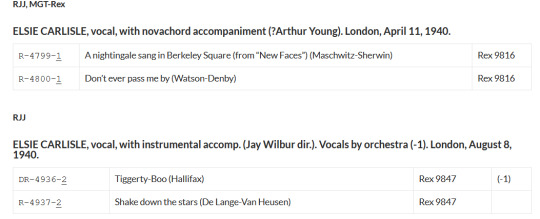
Arthur Young is pianist for A Nightingale Sang in Berkeley Square (only me who finds it amusing to picture Adam's dad here?), then her next record's two songs are Tiggerty-Boo (yes, the song is associated with the expression tickety-boo becoming popular at this time; I googled) and Shake Down the Stars.

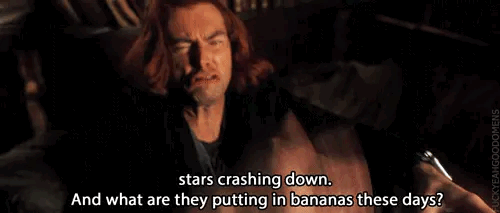
#good omens#good omens music#not really any clues or revelations#just my little adventure through Blitz-era music#a nightingale sang in berkeley square
43 notes
·
View notes
Text
Don't Go Too Fast, but I Go Pretty Far
Our transportation decisions determine much more than where roads or bridges or tunnels or rail lines will be built. They determine the connections and barriers that people will encounter in their daily lives, and thus how hard or easy it will be for people to get where they need and want to go.
Elijah Cummings
In the fall of 2023, I sold my car and used the money to move back to my hometown,…
#a failure to communicate#Azores#Berkeley Study Abroad#car-free#Covid#L.A. &039;28#last summer#Lisbon#Metro#my adventures#only a little lost#passenger#pedestrian#Ponta Delgada#Portugal#public transit#São Miguel#starting over#transportation#walkable#wanderlust
0 notes
Text
What happened to Aziraphale and Crowley between 1941 and 1967?

It is well known by the fandom that Aziraphale realizes he’s in love with Crowley after Crowley saves him and his books from the n4zis in 1941. That moment marks the shift of their relationship, when Aziraphale sees that not only did Crowley know him well enough to save his books, but also was there for the sole purpose of rescuing him - because he cared. This moment led to their most romantic adventure yet, which involved the car “is there anything i can do for you in return?” scene, the magic trick performance, the “trust me” moment and a very intimate, private, candlelit dinner.
They had crossed a very visible line in their relationship, you could see it in the way they were looking at each other, being more open, talking and drinking together. They were acting romantically towards each other, even if they couldn’t admit it or talk about it.
But then, the next time we see them, it’s almost like they moved backwards in they’re relationship. Aziraphale is practically unable to look directly at Crowley when he first gets in the car. And then we get the iconic, yet heartbreaking and confusing “you go too fast for me, Crowley”. And you can see that Aziraphale looks almost mournful after saying that.
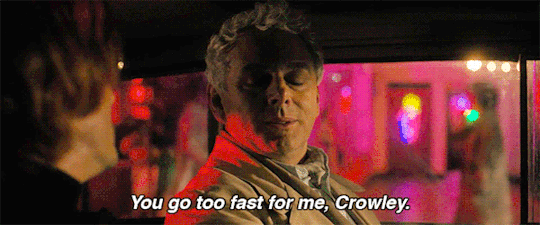
I saw a post on twitter comparing the two car scenes - the one where Aziraphale is practically throwing himself at Crowley and then the one where he’s hesitant towards him.
And it made me think. Like, whatever happened between those two car scenes has an impact that lasts for many years, as we can CLEARLY see that 2008 Aziraphale and Crowley were still a bit colder and more distant than their 1941 selves. Their relationship backtracked a lot from that candlelit dinner. And i don’t think that’s a plot hole, i truly think there’s something we don’t know yet.

Of course, after the events of season one, they’re back to being really close, their dynamic is pretty much restored and we can see them hold hand in the bus - which David Tennant has confirmed happened, and it is heavily implied that Aziraphale stays at Crowley’s that night, where they did the body swap for the trials.
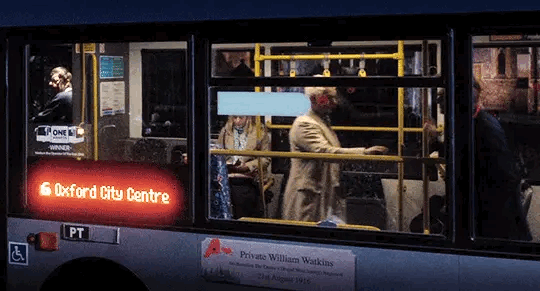
BUT! In the first episode of Season 2, Aziraphale mentions that he had to do the “i’m sorry” dance in 1941. It definitely happened after that candlelit dinner, so could that event - which led to the apology dance - be connected to why they had a temporary falling out? What was it that happened after that dinner? Are we going to see more from 1941?
It has been the only time period that was shown in both seasons, and it was perhaps the most romantic and significant time they’ve spent together prior to the events of season two. Perhaps they went a little too far and weren’t prepared for that? Perhaps they’ve miscommunicated and had a big fight? I don’t know, i’m hoping our dearest @neil-gaiman has an answer for that.

Also, when Crowley says “no nightingales” before kissing Aziraphale, Aziraphale seems to understand perfectly what he’s referring to. He looks absolutely crushed after Crowley says that. So it led me to believe something in the past made them associate “A Nightingale Sang in Berkeley Square” to their relationship and perhaps talk about it. And i believe that, if i am correct and they have talked about the nightingales before, it was in 1941. But then, what do I know?
I would REALLY love to see your theories as to what happened between them after that dinner, if anything at all. Also, does anyone wanna be moots? My posts have been very successful but i’m not getting followers and i really want to meet more of you.
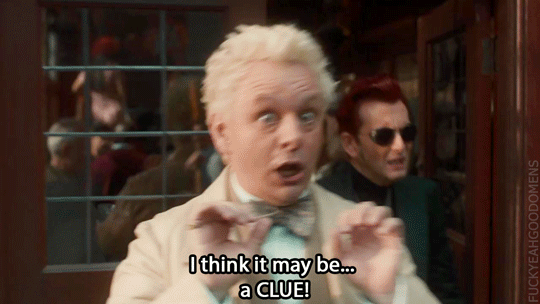
#aziracrow#aziraphale#crowley#good omens#ineffable husbands#neil gaiman#gomens#angel#gomens s2#prime video#go3#good omens season 2#good omens spoilers#need this to happen#neil gaiman books#crowleys bentley#crowley x aziraphale#terry pratchett#a nightingale sang in berkeley square
604 notes
·
View notes
Text
I haven’t been on here in a cow’s age but had to share what I did today with my fellow Esparza Fans:
I BOUGHT TICKETS TO SEE HIM IN GALILEO! 👀
If you hadn’t heard, the musical some of us got to experience in read through version in 2019 at Vassar where I came thisclose to meeting him but chickened out and just took pictures of him talking to other people has finally gone to production. It’s going to be this summer at the Berkeley Repertory Theatre in California. I was on the fence but my sister said she was up for the adventure and I clicked purchase this morning!!!! We are going to the June 8 matinee that has a post show discussion!
Merciful heavens I can’t believe I’m going to get to see him on stage again!
24 notes
·
View notes
Text

I met Kyle K on Telegraph Ave in Berkeley, California on 5/14/2017. He was a handsome blonde 20 year old artist and “Nomad”. He and a friend were headed to Berlin Germany for an adventure. I sat on my back pack as he “drew” me a painting as we dined on Piology Pizza. He drew his painting on the pizza box top. I think that I paid him $25 for his work of art.
#street art work#street artist encounter#Telegraph Ave Berkeley Ca#5/14/2017#the drawing that Kyle K made for me on 5/14/2017
10 notes
·
View notes
Text
2024 Old Hollywood Movies Project
After taking everyone's Old Hollywood movies recommendations into consideration, I've come up with a list of fity or so films to watch this year. I haven't yet decided whether or not I'm going to schedule specific films to specific months (though I will watch the Christmas movies at Christmas) or if I'm going to go by decade or just by list order. We'll see!
I also want to put in a couple of Anna Mae Wong's and Buster Keaton's films, but here is the list as it stands today, January 11th, 2024:
Design for Living, 1933
Morocco, 1930
The Prisoner of Zenda, 1939
My Man Godfrey, 1936
Bringing Up Baby, 1938
Stand-in, 1937
The Thin Man, 1934
The Big Sleep, 1946
The Maltese Falcon, 1941
It Happened One Night, 1934
Ball of Fire, 1941
The Gay Divorcee, 1934
Random Harvest, 1942
Now, Voyager, 1942
Brief Encounter, 1945
Meet John Doe, 1941
The Lady Eve, 1941
The Scarlet Pimpernel, 1934
Berkeley Square, 1933
I’ll Never Forget You, 1951
The Adventures of Robin Hood, 1938
The Mark of Zorro, 1940
The Sea Hawk, 1941
Rebecca, 1940
The Bishop’s Wife, 1947
The Shop Around the Corner, 1940
Scrooge, 1951
The Philadelphia Story, 1940
Holiday, 1938
Without Love, 1945
I Know Where I’m Going, 1945
Dodsworth, 1936
The Furies, 1950
Ninotchka, 1939
Christmas in Connecticut, 1945
Gaslight, 1944
The Crimson Kimono, 1955
Sweet Smell of Success, 1957
The Little Minister, 1943
The Uninvited, 1944
His Gal Friday, 1940
Trouble in Paradise, 1932
The Scarlet Empress, 1934
The Old Dark House, 1932
The Ghost and Mrs. Muir, 1947
The Night of the Hunter, 1955
Queen Christina, 1933
Mr. Blandings Builds His Dream House, 1946
Shanghai Express, 1932
19 notes
·
View notes
Text
I've talked about Hazel ending up at the Lotus Casino, I've talked about Leo ending up at the Lotus Casino, I've talked about Hazel and Leo gaslighting themselves into thinking Leo was actually Sammy, but you know what I haven't done?
Put it all together
Let's miraculous ladybug square this shit (au pending on that), because it could be that both of them remember who they are, or that only one of them remembers or that neither of them remember.
If they both remembered, then honestly, the shock of it might snap them both out of their comatose state, and that in and of itself would be a nightmare for them. Imagine them running out onto the street and just- Hazel canonically almost had a panic attack when she visited Berkeley, Vegas would literally kill her. And it could actually be kind of funny depending on how old Leo was when he first got trapped at the casino because he could have been as young as eight. So Hazel seeing this literal child (which is saying something because she is also a child) and being like... is this my boyfriend's son or... ?
If only Leo remembered, than nothing would happen, they would just exist near each other, and there's something kind of tragic and haunted even in that. Also kind of freeing too though. Like their meeting was always going to be painful for them, and they got to just be in the same place without that pain or weight to carry.
Also, like when they're actually on the Quest (tm) and during a group discussion Hazel casually drops how she spent year x to year y there because she's recovered her memories, and Leo, who's either kept the fact that he stayed there very close to his chest because it's Leo, or has loudly be announcing it to explain why he's so much younger than he should be- anyway he chokes on his drink because what kind of a coincidence is that?
If neither of them had their memories, then it would really depend on like... how sad you want it to be. Like, do they just float around each other and never take notice of one another? Do they meet and become friends willingly, of their own volition? Even if they don't remember all the pain of their pasts, it would still leave some kind of impact on them. If going the sad route, then Hazel still would have died in Alaska but maybe Juno or Thanatos or Pluto did something they technically shouldn't have done and gave her a second chance somewhere new. Because then Hazel would have reason to be proud of her decisions, because her story had come to a resolution, even if a tragic one. Or maybe none of what happened in Alaska happened, and she is just a kid spared a cruel fate that she isn't even aware of. If it's the first, then in comparison, Leo would be at the start of his story, always feeling something is wrong, that he's forgetting something that he knows he shouldn't be, something he did wrong, something that scares him when he tries to think about it.
Or if they weren't weighed down with those wounds, then, yeah, maybe they get a few years of peace and happiness and friendship before the world needed them back and everything they'd been able to forget comes crashing down on them.
If only Hazel remembered then... it really would be like seeing Sammy again. Like, that would be literally the only plausible explanation to her, she has no idea he would have been dead by then. And Leo, who hasn't really spoke to anyone in... he doesn't even know how long, who doesn't even realize he's forgotten his own name because he never has to think about himself in relation to anyone else... he's got no reason not to believe this girl coming up to him, saying they're friends and don't you remember me and seeming so heartbroken at the fact that he doesn't. He doesn't want her to cry, he doesn't want her to be sad, especially not in this amazing place, so yes, of course he wants to know about their old life, of course he wants to hear about their adventures and yes, he wants to be this person she's describing, and it feels so good to have an identity again, a name and past and friend, and-
#this is a lot longer than i planned#hazel levesque#leo valdez#sammy valdez#lotus casino#son of neptune#the lost hero#the mark of athena#heroes of olympus#hoo#yes the miraculous square au was a joke but not in the sense that i actually don't have one cooking#... in a really slow cooker it's been more than 2 years 🤷🏽♀️#I mean its VZ but h&l friendship is important in it… I think I’m talking myself into working on it again 🤔
13 notes
·
View notes
Text
Mick was close to Keith Richards and Anita Pallenberg who lived on the same road. After one visit to their house, I decided to keep my distance. I didn't find their being into hard drugs cute or adventurous. (A couple of the people that I had met in Berkeley in the summer of 1964 were dead from overdoses.) Mick doted on Keith, and I didn't voice any opinion but I avoided contact.
Marsha Hunt, Real life.
#mick jagger#keith richards#marsha hunt#anita pallenberg#Real life#the rolling stones#old rockstar#70s rock#classic rock#rockstar gf#70s era#my old man#70s music#60s music#60s era#60s rock#60s#book quotes#quotes#rockstar boyfriend#rockstar girlfriend#blues rock
9 notes
·
View notes
Text
hello everyone !! hitting the tags to see if anyone is interested in some discord rping with my silly muses because i miss roleplaying. 20+. m/f, m/m & f/f pairings. i'm very partial to angst-ridden, long, dramatic threads. nsfw & dark themes are alright. like if you're interested!
will be leaving a summarized list of some of my muses under here!
arabella. fantasy setting. dragon that can shapeshift into a human form, and is more often than not in said human form. she resides in a village, living among other people, and acts as a sort of 'healer'. trusting to a fault. kind. generous.
paul berkeley. 1980s model. eccentric. outrageous. well known for his distinctive look, as he's often seen with long, black hair, wearing makeup & clothes that make him look androgynous.
helena monroe. 1920s. cabaret dancer & courtesan. blonde, always wears her hair in pigtails, wears flashy outfits & bright makeup to achieve a 'doll like' appearence. bubbly and flirty. loves to perform. dreams of getting out one day and become an actual dancer & showgirl.
grace scarlett woods. 1930s/40s. heiress. daughter of a prime minister. spoiled. bratty. her father's at work all the time, so she's pretty much neglected when it comes to love & attention. because of that, she tends to act out. dating the wrong people, going out partying, drinking, getting into mischief, etc. it never seems to work out the way she wants it to.
rhiannon. set in the 1970s/80s. groupie. lives in a tiny flat, and works at a record store. when she has free time, you can find her catching a ride with the first van she finds & going to concerts. you can also find her backstage after said concert, hanging around rockstars -- and, more often than not, ending up in bed with them. enimatic. free spirited. adventurous.
nancy alden. set in the 1950s. preacher's daughter. reserved. innocent. bit of a 'prude'. shy. often keeps to herself.
#discord 1x1 rp#1x1 rp#discord rp#( thought i'd get this out again now that i finally have some writing time#btw totally willing to make more ocs beyond these#or put them into a modern au!#i just like period things haha )
8 notes
·
View notes
Text
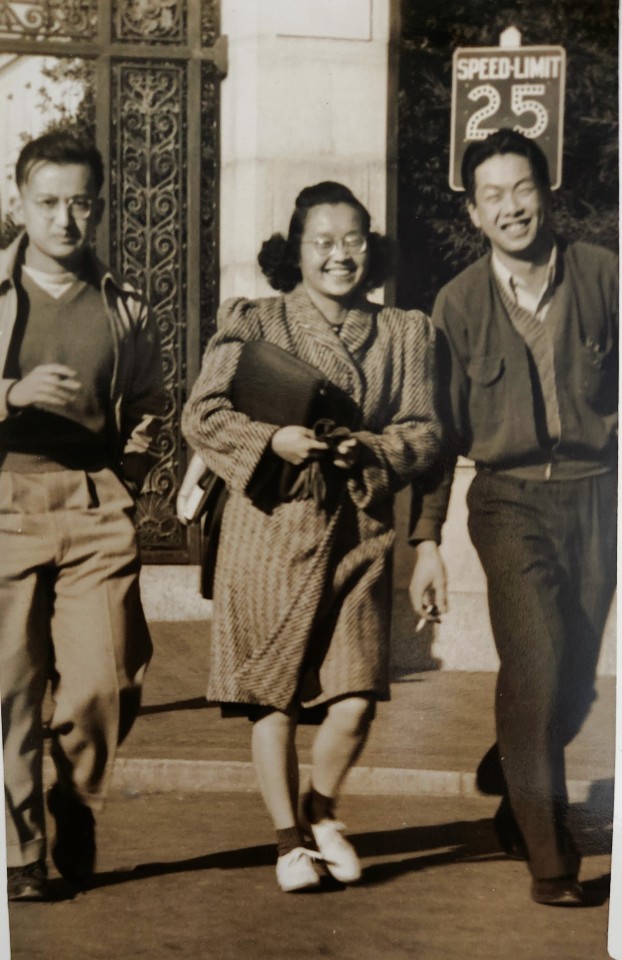
(left to right) "Walter," Phyllis Soohoo, and Kenny Kai-Kee outside Sather Gate on the campus of the University of California Berkeley, c. 1940. Photographer unknown (from the collection of Doug Chan).
War and Mother's Remembrance
In an old photograph, a smiling Chinese coed strolls out of the University of California Berkeley’s Sather Gate, circa 1940. Observing this image, one cannot help but infer that my future mother didn’t lack for male companionship eight decades ago. However, beyond the personal anecdote, the photograph of the trio encapsulates a broader narrative about the adventurous spirit of Chinese American youth who began entering college in significant numbers on the cusp of the Second World War.
The Chinese students who enrolled at Cal in the late 1930’s represented a subset of the second or third generation offspring of the Chinese settlers in California. Despite being a minority, these students embodied the inaugural All-American generation of the Chinese diaspora in the US.
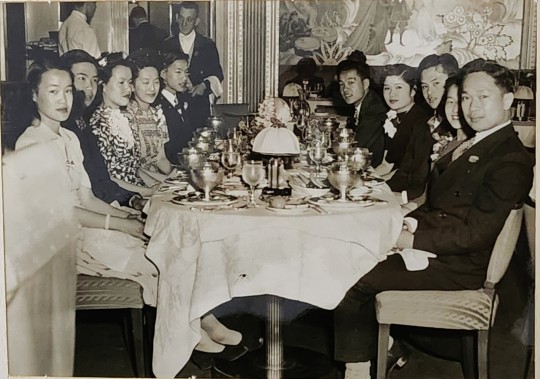
Chinese collegians dine at the Persian Room in the Sir Francis Drake Hotel, June 12, 1942. Hollywood Nite Club Photos (from the collection of Doug Chan). Phyllis Soohoo appears second from right.
The confluence of access to higher education and the backdrop of WWII proved to be a watershed moment for Chinese American youth. The war coincided with the formation and facilitated the ascent of the first Chinese American middle class.
With the outbreak of war, my mother took breaks to work for Shell Oil Co.'s laboratories, where she contributed to the development and testing of waterproofing treatments for equipment such as tents. Alongside other Chinese American men and women on the homefront, she undertook real jobs for the first time outside of the segregated Chinatowns. Her generation garnered newfound respect from their compatriots and the larger society amidst an era scarred by exclusion.
Time and the passing of her generation have dimmed the sacrifices made by many of my mother's contemporaries and, most poignantly, the memories of young men who had served and fallen in combat.
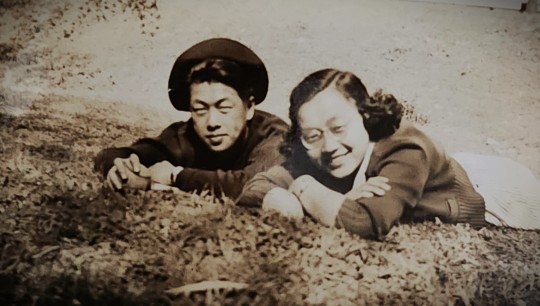
UC Berkeley classmates Kenny Kai-Kee and Phyllis Soohoo at Lake Lagunitas, March 21, 1940. Photographer unknown (from the collection of Doug Chan).
Kenny Kai-Kee was the classmate and a friend seen at the right in my mother's photograph outside of Sather Gate. Remembered as a jovial and talented athlete who secured a spot on Cal's varsity basketball team, Kenny would earn a lieutenant's commission, joining the US Army Air Force in October 1943 and qualifying as a bomber pilot. As recounted in my earlier writing here, this year marks the 80th anniversary of the downing of Kenny’s B-17 to enemy fire over Austria in late July 1944.
My mother, Phyllis Soohoo, was a compulsive archivist. She kept all of the half-dozen photos of her and her former boyfriend, Kenny. She would continue to refer to grief-stricken parents, Lock and Rita, as “Mom” and “Pop,” and send them a Christmas card every year after that terrible summer of 1944. Years later, when her own family went out for dinner in Oakland, she would meet and greet Kenny’s parents on the sidewalks of Chinatown as the old-time families usually encountered each other going to or from dinners at the old Silver Dragon.
Kenny’s remains had been interred initially in a distant plot. The German records recorded a burial first on July 27, 1944, in the cemetery of St. Jakob i. Walde, Austria. More than five years later, Lock and Rita were notified that Kenny’s remains were coming “home” to be re-interred at the Jefferson National Cemetery Barracks. His parents traveled back to St. Louis, Missouri, to witness the re-interment, which occurred on May 15, 1950.
No one can recall if Lock and Rita Kai-Kee ever revisited their son’s lonely grave in St. Louis, so far from family, friends and loved ones. If my mother knew of the location of Kenny’s grave when a cross-country motor trip with her family drove her through St. Louis in the summer of 1964, she never mentioned it. On the two or three times when I had asked her about Kenny, I recall her fleeting, faraway look when she mentioned his name. She and millions of other Americans knew first-hand not only the young men who never returned from the great global conflagration of the 1940s, but the loss, grief, and the waste of war. Like many other Americans who were left behind in sorrow, my mother emerged from the war years with not only her pharmacist's license but also specific, painful reasons to detest the horrors of the global conflict and its waste of life.
Another decade would pass before Mom crossed paths with my father. He had shared none of the transformational experiences of my mother's college cohort. His family had struggled during the years of the Great Depression in San Francisco Chinatown, and he lacked the means, and perhaps the inclination, to pursue university education before enlisting in the US Coast Guard.
Rita Kai-Kee would carry the bitterness of Kenny's loss and the cruelty of war’s cost until her death in August 1983. Lock died seven months later.
After my mother's passing in 2001, my then-grieving father had dispassionately set all of her personal effects, records, and old photos for disposal. I reclaimed a portion of her captured memories from a grim jumble of items he had discarded for the dump. Among the carefully compiled sets of letters and photos about her side of the family, were the small snapshots of her with Kenny. My mother’s archive provided glimpses into a personal life in which Dad had played no part, separated by a ferry ride and later a new Bay Bridge. As such, her mementos formed a sentimental narrative, ending on the eve of her encountering my father in San Francisco Chinatown’s Powell Garage in 1953.
I was brought into the world about a year later. Decades later I would find among a pile of baby gift cards from family and friends the small card sent to my mother by “Mom” and “Pop” Kai-Kee. Their names had been included on the baby announcement list.


The war coincided with the making, and spurred the rise, of the first Chinese American middle class. As the image and condition of the Chinese in America changed, so did its economic opportunities. By 1943 -- the year the Exclusion Act was repealed -- 15 percent of the shipyard workers on San Francisco Bay were Chinese. During the war, Chinese American men and women were working real jobs for the first time in the world’s only industrial behemoth and gaining new respect from their fellow citizens.
The loss of Kenny Kai-Kee, the only son of a pioneering family, was doubly bitter because he exemplified the first All-American generation of Chinese. Death deprived him of the realization that the Second World War proved to be a watershed event for Chinese American youth. The young men and boys who flew in the B-17s of the 8th and 15th Air Forces came home to a Chinese America not quite free of the strictures of white racism, but well on its way to equal rights for Chinese Americans, freed from the Chinese Exclusion Act.
Back in Oakland, Kenny would have heard the laughter of unprecedented numbers of children in the Nation’s Chinatowns. He would have seen his buddies buying houses in gradually desegregating neighborhoods, resuming college careers on the G.I. Bill, and wading into the social and cultural mainstream of postwar America.
We will never know what Kenny could have accomplished had he lived. Had he stayed in Oakland, he probably would have married the love of his short life, raised a family, and grown old. We would have seen him as just another 80-year-old senior citizen, serving up decades' worth of easy banter along with the stacks of pancakes at the Wa Sung Club’s annual Easter breakfast. As a member of one of Chinese America’s greatest generations, he would have made his own contribution.
Instead, we are left only with the perplexing example of the wrenching deaths of Kenny and the thousands of other young men who never made it back home. Such selflessness demands that we ponder the meaning of his brief life and how in our time, beyond the words and through our own deeds, we as Americans can make his death meaningful and us worthy of such a sacrifice.
If the task of reclaiming the history of Chinese America must begin anew with each generation, then the stories not only of gallantry but also of sacrifice should be told again. Each retelling represents a call for new generations, native and immigrant, to engage in a singular act of faith in the future and reaffirmation of hope that the mere utterance of the names will sustain the memories of the lives, the valor, and the sacrifices of the Chinese Americans who marched, sailed or flew in harm's way. Such is the heavy burden on ethnic historians and storytellers to remember the community’s forgotten men in unforgettable ways.
[2024-7-30]
2 notes
·
View notes
Text
I just had an adventure talking with my mom about family recipes.
My mom's cousin insisted his mom made these cookies for Easter ever year called "pughena" [sic]. They were a thin, almost puff pastry-like dough made from egg whites that you would cut into strips, twist twice, and deep fry. These would have been a Slovenian recipe.
After looking around for a while, I found kichel, a Jewish recipe with, sure enough, an egg-heavy dough that you twist, but you bake it instead of frying it.
Just by chance, the suggested recipe at the bottom of the kichel recipe was rugelach, a crescent-shaped pastry that's also traditionally Jewish.
Looking elsewhere, I finally found what I was looking for. The Polish version calls the cookies chrusciki, the Slovenian version that my mom probably knew is flancati, and notably, neither is called pughena.
So, here's my theory on the timeline of events.
My mom's cousin's mom makes flancati every Easter.
Several decades pass, and my mom's cousin forgets that they're called flancati, but remembers that they're an eggy cookie with a twist.
At some point, he becomes acquainted with the world of Jewish cuisine. My best bet is when he was drafted into the Vietnam War, but he also lived in Berkeley for a while, which is a more-Jewish-than-average area of California. He learns about kichel and rugelach, and the kichel reminds him of the flancati he grew up eating.
Years pass and he conflates the kichel and rugelach and mixes their names up, and furthermore perverts "rugelach" into "pughena".
#this is a shitpost#sorry for posting about eastern European cuisine twice in one day. except I'm not#look at my culinary traditions boy
2 notes
·
View notes
Text
Mexican Alfredo Quiñones-Hinojosa: From Migrant Farmoworker to Neurosurgeon
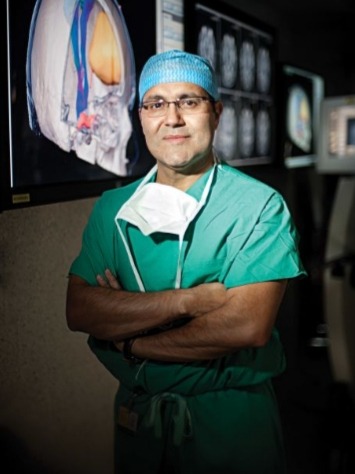
Dr. Quiñones-Hinojosa is a world-renowned neurosurgeon and researcher who specializes in brain tumors. Originally from Mexicali, Baja California, Mexico, Dr. Quiñones-Hinojosa was just nineteen years old when he came to the United States. According to a CNN profile, he worked as a migrant farmer until he enrolled in university, graduating from the University of California at Berkeley when he was 23. Dr. Quiñones-Hinojosa went on to attend Harvard Medical School and began his career at Johns Hopkins School of Medicine where he led the Brain Tumor Stem Cell Laboratory and published extensively on the role of stem cells in brain tumors and their potential impact in fighting brain cancer. Today, he is Chair of Neurosurgery at the Mayo Clinic in Florida, where works in the clinic and leads NIH-funded brain cancer research. Over the years, he has had many scientific accomplishments, including developing new software to help identify tumor areas with the greatest malignant potential and developing new and minimally invasive surgical procedures.
Dr. Alfredo Quinones-Hinojosa insists, “I just think of myself as a regular guy.”
“I’ve never been one who declines adventure,” he says.
Early life
The oldest of five children, Quinones-Hinojosa as a child had nightmares that he had to save his mother and siblings from fires, floods, avalanches, says his memoir, “Becoming Dr. Q,” which he co-authored.
His interest in medicine may have stemmed from this sense of responsibility, along with his baby sister’s death from colitis (the memoir is dedicated to her).
Short visits to California’s San Joaquin Valley, where Quinones-Hinojosa’s uncle Fausto was a foreman at a ranch, is where he worked at age 14, he spent two months there pulling weeds, making money to bring back to his family.
“That hard-earned cash proved that people like me were not helpless or powerless,” he wrote.
His uncle agreed to let him work a short stint again at the California ranch to supplement his income. A plan began to form in his mind.
Passage into the United States
Quinones-Hinojosa had $65 in his pocket when, the day before his 19th birthday in 1987, he decided to cross into the United States.
Risking arrest, deportation and even death, Quinones-Hinojosa had a plan: He would cross the border in a “Spider-man climb” up an 18-foot-fence, hop over the barbed wire and make a leap into California, he wrote.
With his uncle’s assistance, Quinones-Hinojosa ended up back in the fields in the San Joaquin Valley. The vast farming terrain was teeming with corn, grapes, tomato, cotton, cantaloupe, broccoli, cauliflower. He lived in a trailer.
“There’s a lot of sentiment against immigration nowadays, but at the time, when I came, the U.S. needed my labor.” Quinones says.
Quinones-Hinojosa remembers driving a tractor and seeing agents of the Immigration and Naturalization Service pass by. They would take other workers away, but somehow, he avoided being caught.
Quinones-Hinojosa had wanted to make enough money for his parents and siblings – who later came to the United States as well – and intended to go back to Mexico after saving money. “When you’re making $3.35 an hour, you realize that that dream is going to take a lot longer,” he says.
A different education
Quinones-Hinojosa spent two years at San Joaquin Delta College, taking classes during the day and continuing work for California Railcar Repair in the afternoon.
Quinones-Hinojosa got offers from several universities, he recalls. He chose University of California, Berkeley, because of the scholarship the school offered, but also because he learned it was the epicenter of a social movement in the 1960s. He enrolled at age 23.
But the environment wasn’t entirely supportive. A teaching assistant once told him, “You can’t be from Mexico. You’re too smart to be from Mexico.” He said nothing, but the comment stung. These words would later spur him on to prove people like this wrong.
Next stop: Harvard Medical School. When he matriculated, the U.S. population was about 18% minority, but faculty at medical schools was only about 3.7% minorities, Quinones-Hinojosa wrote in an article in the New England Journal of Medicine. While a student, he earned his U.S. citizenship in 1997.
One of his medical school classmates told him no one could pronounce “Alfredo Quinones,” and suggested he change his name to Alfred Quinn. Instead, he lengthened his name to Alfredo Quinones-Hinojosa, honoring his mother’s family.
“Alfredo is an outstanding surgeon, and takes very humane and very skilled care of patients with brain tumors,” says chairman of the department of neurosurgery at Johns Hopkins Medicine. “His mission is to not only deliver the best possible care, but also to do cutting edge research in order to better understand the diseases and to ultimately find better therapies for those diseases.”
Despite Quinones-Hinojosa’s prominent career, longtime friend, a professor of neurobiology at Harvard Medical School, describes him as down-to-Earth: “He’s easy to talk to to. He puts his hand out to shake your hand, and it’s this wonderful warm grip. He’s super friendly. Nothing at all pompous about him.”
Operating on the brain
As a migrant farmer, Quinones-Hinojosa’s work was full of hazards. With the machinery he operated, a wrong move could mean his finger or hand might be gone; he could even have lost his life. One machine he sat on, for picking tomatoes, he called “the astronaut chair.” He had to manage it with both hands and arms.
These days, at Johns Hopkins, he has a different “astronaut chair” – where he sits in the operating room, using his hands, feet and mouth to control instruments and a microscope.
“All that practice began when I was working in the fields,” he says.
Quinones operates on about 250 brain tumors every year. He uses his operating room as an extension of his laboratory. He wants to learn the motor pathways of the brain, what makes the cells “move like spiders” and how to attack them.
He’s working on a method to use human fat cells to fight brain cancer. From the fat, researchers derive mesenchymal stem cells, which appear to be effective in identifying cancer.
“It’s almost like you give a hunting dog something to smell,” Quinones said. “We give the cells the smell of cancer juice and they go back and chase these cancers incredibly well.”
You can tell how much Quinones-Hinojosa loves what he’s doing now by the way he talks about the brain.
Brain cancer, he says, is “the most devastating disease that affects the most beautiful organ in our body: the brain. I’m biased because I’m a brain surgeon."
A patient of 56 years of age of Annapolis, Maryland, learned she had large brain tumor – a non-cancerous meningioma – in 2008. Nervous about her first appointment with Quinones-Hinojosa, she found him to be “a ball of energy,” who was confident that she would be OK.
“He’s just so kind and so friendly and he feels like he’s somebody that you’ve known all your life,” she said.
The morning of the surgery, Quinones-Hinojosa eased the patient's fears. “He told me, ‘No matter what happens in the rest of the world, I will not leave you, you are my concern,’ ” she remembers.
“I guess that’s the thing that makes him so kind and so compassionate, is where he came from,” she said.
In some ways, Quinones-Hinojosa, now 45, is a “regular guy.” He wants his three children – 7, 11 and 14 – to be happy. He tries to exercise to keep himself in good shape, especially for the half-marathons he runs with patients to raise money for brain cancer. He uses the expression “holy guacamole.”
There have been so many moments in his life when a combination of luck and determination carried him through.
Sources: (x) (x)
#🇲🇽#STEM#Alfredo Quiñones-Hinojosa#hispanic heritage month#mexican#immigration#latino#hispanic#discrimination against mexicans
5 notes
·
View notes
Text
Paradise Found
We all long for Eden, and we are constantly glimpsing it: our whole nature at its best and least corrupted, its gentlest and most human, is still soaked with the sense of exile.― J.R.R. TolkienThe Letters of J.R.R. Tolkien
On the island of São Miguel weather reports should be regarded as speculative fiction. Our professor advised us to bring layers and bathing suits for every outing. The layers…

View On WordPress
#Azores#Berkeley Study Abroad#but did you die#fancy water#Furnas#hanging out in a volcano#isn&039;t it romantic#it&039;s all okay in the end#last summer#my adventures#Portugal#São Miguel#wanderlust
0 notes
Photo
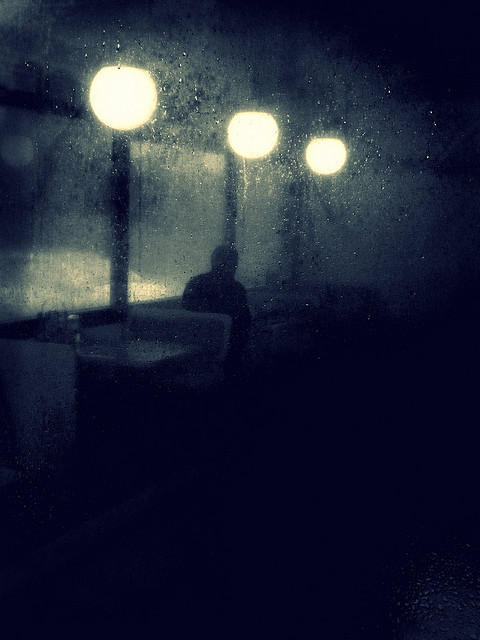
Advent Adventure
Slacktivist
A tent among us
This is from Anne Lamott’s “Advent Adventure,” from her old “Mothers Who Think” column on Salon.
Merry Christmas, blessed Solstice, happy Hannukah. Emmanuel.
- - - - - - - - - - - -
So I called my Jesuit friend,Tom, who is a hopeless alcoholic of the worst sort, sober now for 22 years, someone who sometimes gets fat and wants to hang himself, so I trust him. I said, “Tell me a story about Advent. Tell me about people getting well.” He thought for a while. Then he said, “OK.”
In 1976, when he first got sober, he was living in the People’s Republic of Berkeley, going to the very hip AA meetings there, where there were no fluorescent lights and not too much clapping – or that yahoo-cowboy-hat-in-the-air enthusiasm that you get in L.A., according to sober friends. And everything was more or less all right in early sobriety, except that he felt utterly insane all the time, filled with hostility and fear and self-contempt. But I mean, other than that everything was OK. Then he got transferred to Los Angeles in the winter, and he did not know a soul. “It was a nightmare,” he says. “I was afraid to go into entire areas of L.A., because the only places I knew were the bars.
So I called the cardinal and asked him for the name of anyone he knew in town who was in AA. And he told me to call this guy Terry.” Terry, as it turned out, had been sober for five years at that point, so Tom thought he was God. They made arrangements to go to a meeting that night in the back of the Episcopal Cathedral, right in the heart of downtown L.A. It was Terry’s favorite meeting, full of low-bottom drunks and junkies – people from nearby halfway houses, bikers, jazz musicians. “Plus it’s a men’s stag meeting,” says Tom. “So already I’ve got issues. "
There I am on my first date with this new friend Terry, who turns out to not be real chatty. He’s clumsy and ill at ease, an introvert with no social skills, but the cardinal has heard that he’s also good with newly sober people. He asks me how I am, and after a long moment, I say, ‘I’m just scared,’ and he nods and says gently, 'That’s right.’ "I don’t know a thing about him, I don’t know what sort of things he thinks about or who he votes for, but he takes me to this meeting near skid row, where all these awful looking alkies are hanging out in the yard, waiting for a meeting to start. I’m tense, I’m just staring. It’s a whole bunch of strangers, all of them clearly very damaged – working their way back slowly, but not yet real attractive.
The people back in Berkeley AA all seem like David Niven in comparison, and I’m thinking, Who are these people? Why am I here? "All my scanners are out. It’s all I can do not to bolt. "Ten minutes before the meeting began, Terry directed me to a long flight of stairs heading up to a windowless, airless room. I started walking up the stairs, with my jaws clenched, muttering to myself tensely just like he guy in front of me, this guy my own age who was stumbling and numb and maybe not yet quite on his first day of sobriety.
"The only things getting me up the stairs are Terry, behind me, pushing me forward every so often, and this conviction I have that this is as bad as it’s ever going to be – that if I can get through this, I can get through anything. Well. All of a sudden, the man in front of me soils himself. I guess his sphincter just relaxes. Shit runs down onto his shoes, but he keeps walking. He doesn’t seem to notice. "However, I do. I clapped a hand over my mouth and nose, and my eyes bugged out but I couldn’t get out of line because of the crush behind me. And so, holding my breath, I walk into the windowless, airless room.
"Now, this meeting has a greeter, which is a person who stands at the door saying hello. And this one is a biker with a shaved head, a huge gut and a Volga boatman mustache. He gets one whiff of the man with shit on his shoes and throws up all over everything. "You’ve seen the Edvard Munch painting of the guy on the bridge screaming, right? That’s me. That’s what I look like. But Terry enters the room right behind me. And there’s total pandemonium, no one knows what to do. The man who had soiled himself stumbles forward and plops down in a chair. A fan blows the terrible smells of shit and vomit around the windowless room, and people start smoking just to fill in the spaces in the air. Finally Terry reaches out to the greeter, who had thrown up. He puts his hand on the man’s shoulder. "Wow,” he says. “Looks like you got caught by surprise.” And they both laugh. Right? Terry asks a couple of guys to go with him down the hall to the men’s room, and help this guy get cleaned up. There are towels there, and kitty litter, to absorb various effluvia, because this is a meeting where people show up routinely in pretty bad shape. So while they’re helping the greeter get cleaned up, other people start cleaning up the meeting room.
Then Terry approaches the other man. “My friend,” he says gently, “it looks like you have trouble here.” The man just nods. “We’re going to give you a hand,” says Terry. “So three men from the recovery house next door help him to his feet, walk him to the halfway house and put him in the shower. They wash his clothes and shoes and give him their things to wear while he waits. They give him coffee and dinner, and they give him respect. I talked to these other men later, and even though they had very little sobriety, they did not cast this other guy off for not being well enough to be there. Somehow this broken guy was treated like one of them, because they could see that he was one of them. No one was pretending he wasn’t covered with shit, but there was a real sense of kinship. And that is what we mean when we talk about grace.
"Back at the meeting at the Episcopal Cathedral, I was just totally amazed by what I had seen. And I had a little shred of hope. I couldn’t have put it into words, but until that meeting, I had thought that I would recover with men and women like myself; which is to say, overeducated, fun to be with and housebroken. And that this would happen quickly and efficiently. But I was wrong. So I’ll tell you what the promise of Advent is: It is that God has set up a tent among us and will help us work together on our stuff. And this will only happen over time.”
(Copyright © 2000 Salon.com All rights reserved.)
Posted by Fred Clark on Dec 25, 2008
15 notes
·
View notes
Note
Ok 1 Sendai sounds boss as hell l gotta get up there
2 adventure playground in Berkeley CA also had a like. Find some nails and use them type feature where kids built the playground and could use tools borrowed from a responsible adult working there!
it's definitely a unique and great place, I'm excited to gradually explore everything and share it with everyone :D
I see!! I'm glad the concept exists elsewhere. I have an interest in children's environments that are like... benignly dangerous. I think some risk and independence in a controlled environment is important, but this is not my field of study or anything. the angle of learning to build things and have others appreciate what you've made is underutilised. I definitely want to go and check out these parks myself, what an intriguing collection of environments
2 notes
·
View notes
Text
I did a running commentary in my notes app while watching and I don't have a friend irl or online to dump to so I'll just leave this here
Ep 1
Omg baby Crowley
Crowley putting his wing over Az to protect from stars!!!
Love the snake belt crowley
"You have three reasons for calling me: you're bored, you need to tell someone about something clever you did before you pop, or something's wrong."
Aziraphale just walking off with Cafe plates
Beelzebub looks like they have braces and reminds me of a young boy
Loverboy playing while he furiously drives to see Aziraphale and apologise
"I'm back" (grumpy)
A miracle only the most archangel could perform. Crowley=Raphael?!?
Ep 2
Nooooo the goats
Nina's in an abusive relationship?
Why is Crowley looking so unfashionable in the bookshop. He is rivalling Jim
Job era Crowley looks like the 70s
Ooooo Aziraphale remembers angel Crowley
Aziraphale hates food? Crowley seems to like it? What world is this
"I thought I might take the car. What car? Our car. We don't have a car"
"Your just an angel who goes along with heaven as far as he can"
Ep 3
For Heaven sake stop bullying Muriel
I'm tense for you Crowly watching Aziraphale drive the car. My toes are curling
X-ray: David Tennant has occasionally played a doctor. He sure has
Ep 5 + 6 because I forgot to separate
Face masks for the hoard of Demons to prevent covid. Nah it's protecting the humans from the horrors
Aziraphale is being so cute and excited wanting to dance
"I just made up a rule that they're too stupid to check.I'm getting the humans out of here then I'm coming back.I won't leave you on your own" Awww
Crowley will be back in a moment, he will have a plan""Why don't you stand up for yourself? Make your own plan""I am but rescuing me make him so happy"
Fire extinguishers all over the shop because there was a fire😭
"For one prince if Heaven to be cast into the outer darkness makes a good story. For it to happen twice, makes it look like there is some kind of institutional problem."
Beelzebub and Gabriel chats are actually canon now
Oh they're done this a few times
Ineffable Husbands has Nightingales Sang in Berkeley Square. Ineffable Bureaucracy is Everyday
Omg is actually is their song
"Wherever Beelzebub is...is my heaven"
How do Beelzebub and Gabriel hold hands before the Husbands do
That LOOK the the Metaton gave Crowley before joining Aziraphale. Run Aziraphale Run
No no no no please don't leave each other.
KISS. I am shaking. It wasn’t the best conditions and I wasn't expecting it because i avoided The Leak
Wooo Azzy and Crowley solo adventures. I can't wait
6 notes
·
View notes